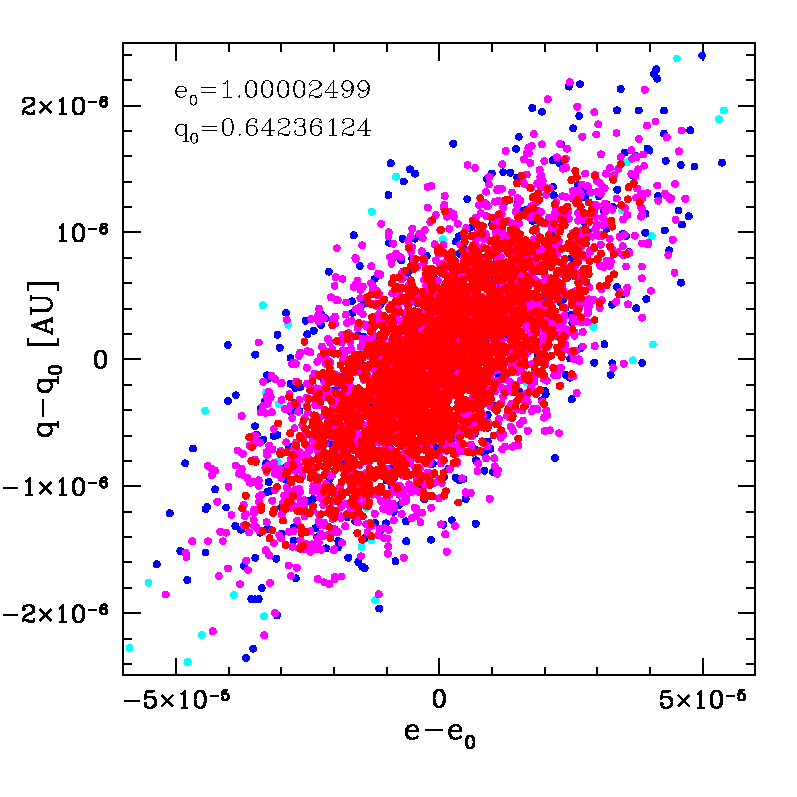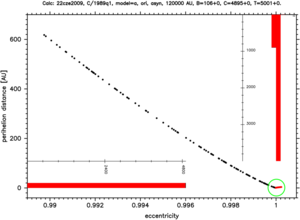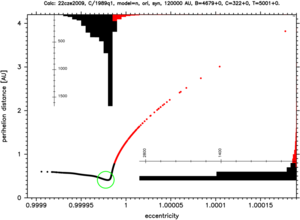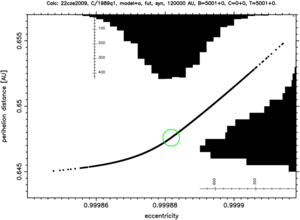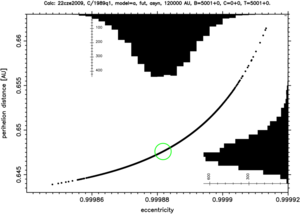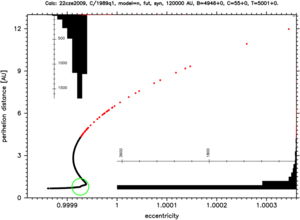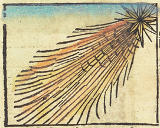Important note: this is a comet with the shortest observational arc (only 4 months) among 26 comets studied in Paper 1.
NG solution is very sensitive to data selection, especially the last four observations are crucial.
Nongravitational nominal solution
Observational arc: 1989 08 24 - 1989 12 24 Number of observations: 231 RMS: 1.30 arcsec (452 residuals used, 2.2% rejected residuals )
Heliocentric osculating orbit
Epoch Perihelion time q e ω Ω i
1989 11 10 19891111.914664 0.64236124 1.00002499 150.564098 275.510766 90.146682
± 0.000138 0.00000070 0.00001665 0.000214 0.000275 0.000248
NG parameters:
A1 = (3.3963 ± 0.3166 )×10-8 AU/day2
A2 = (0.50594 ± 0.14935)×10-8 AU/day2
A3 = 0 (assumed)
Barycentric nominal original orbit (at 250 AU from the Sun)
Epoch Perihelion time q e ω Ω i
1691 10 03 19891110.997525 0.64067522 0.99996503 150.615125 275.483548 89.972889
± 0.000392 0.00000348 0.00001425 0.000450 0.000276 0.000251
1/aori = (+42.90 ± 22.24)×10-6 AU-1
Barycentric nominal future orbit (at 250 AU from the Sun)
Epoch Perihelion time q e ω Ω i
2288 05 26 19891112.554362 0.64134280 0.99993982 150.503112 275.566667 90.139492
± 0.000172 0.00000894 0.00001752 0.001486 0.000276 0.000246
1/afut = ( +80.49 ± 27.32)×10-6 AU-1
In the 17th edition of the Catalogue of Cometary orbits (2008):
Nongravitational orbit (180 obs.) with A1 = +3.4 ×10-8 AU/day2 and A2 = +0.6 ×10-8 AU/day2
The same comet in some other internet sources:
More details
Starting swarms of VCs...(heliocentric, osculating orbits)
Original and future orbit at the 250 AU from the Sun.
Comet number 11 in the Table: Nongravitational Oort spike comets (26 objects)
| Name | GR (1/a)ori [10-8 AU/day2] | GR (1/a)osc [10-8 AU/day2] epoch [TT] | GR 1/afut [10-8 AU/day2] | RMSGR [arcsec] | NG (1/a)ori [10-8 AU/day2] | NG (1/a)osc [10-8 AU/day2] epoch [TT] | NG 1/afut [10-8 AU/day2] | RMSNG [arcsec] | NG parameters A1 A2 A3 [10-8 AU/day2] tau shift [day] | |
| 11 | C/1989 Q1 Okazaki-Levy-Rudenko weighting | -12.14 ± 14.02 | -256.94 ± 13.88 1989 11 10 | 182.62 ± 14.02 | 1.84 | +42.90 ± 22.24 | -38.90 ± 25.92 1989 11 10 | +80.49 ± 27.32 | 1.30 | 3.396 ± 0.316 0.5059 ± 0.1493 |
Note: in the following plots black denotes returning clones while red denotes escaping ones.The nominal solution is located at the center of the green circle. Each plot have a header where date of calculation and some other parameters are coded. Also numbers of returning (B=shown+omitted), escaping (C=shown+omitted) and all (T=shown+omitted) Vcs are shown.
Past orbits, at previous perihelion for the returning VCs
Future orbits, at next perihelion for the returning VCs

